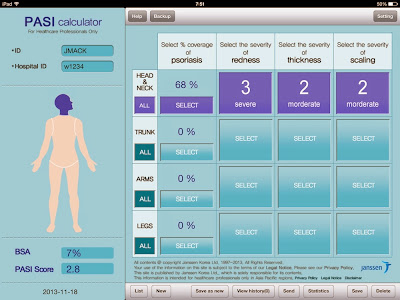I just downloaded onto my iPad the “Psoriasis Severity Calculator” app, which is a PASI (“Psoriasis Area and Severity Index”) calculator for use by physicians developed by Janssen Korea. It’s optimized for iPad use.
Another Janssen psoriasis diagnosis app for physicians that I reviewed (here) is “PASI Calculator,” which was released by Janssen N.V. (Belgium). This version is optimized for the iPhone.
The two apps are very different aside from the platforms they are designed to run on.
The Janssen Korean iPad app, which is in English, is more sophisticated than the Janssen Belgium iPhone app, which may no longer be available (I can’t find it in the U.S. iTunes store).
The iPad app, for example, allows physicians to save data for different patients and email that data to themselves (or any email address), which may pose privacy/HIPAA issues if the physician user isn’t careful. The program does not encrypt any data, including the patient ID entered by physician users. I was able to enter my real name in the patient ID field (see screen shot above). The app’s privacy policy does not address this issue:
At least this app does not surreptitiously monitor the “personal use of the Application” as does (or did) the iPhone version.
But this app suffers from the same shortcoming I found in the iPhone version: neither app tells us anything about how the calculations are made — that is, they do not reveal the sources of the algorithm by which they calculate PASI. As I noted previously (here), there are different algorithms for calculating PASI. I assume a physician would want to know which one was being used in the app.
The other, perhaps more important, issue is whether or not the app has been sufficiently tested to ensure that it provides the correct results whatever the algorithm may be. Recall that at least one pharma mobile app had to be recalled because “a bug in the app … gives wrong results” (see “The First Ever “Dear Doctor” Letter Regarding a Mobile Medical App Recall“)
Of course, Janssen has a disclaimer and accepts no responsibility for such errors:
“The content of this application shall not substitute any diagnosis and treatment by a medical personnel, and any decision regarding a patient’s condition shall be made based upon the medical decision made by the practitioner in charge of the patient. Janssen Korea Ltd., its affiliates and each of their officers and employees shall have no legal responsibility regarding the content of, the result of the use of, the risk management of data loss of, and/or decisions made based on the use of this application.”
Pharma mobile apps such as these PASI calculators may not be Mobile Medical Apps (MMAs) subject to regulation by the FDA, but they should comply at least with a voluntary set of principles such as the eHealth Code of Ethics I helped develop years ago (find it here).
One principle mentioned in that code is very applicable to these apps: “Provide the information users need to make their own judgments about the health information, products, or services provided…” Here’s how I would modify the wording of that principle to apply to mobile apps, which were not available when the code was written in 2001:
“Individuals need to be able to judge for themselves the quality
of the health information they find in mobile apps. Apps should
describe clearly and accurately how content is developed for
the app by telling users
- what sources the app or app provider has used, with
references or links to those sources - how the app evaluates content and what criteria are used to
evaluate content, including on what basis the app decides to
provide specific links to other sites or service. For example, by describing the app’s editorial board and
policies.”
As they say, “Those who ignore history are doomed to relive it over again.”










![6 Digital Tools at the Center of Healthcare Digitalization [INFOGRAPHIC]](http://ec2-54-175-84-28.compute-1.amazonaws.com/pharma-mkting.com/wp-content/uploads/2021/04/6DigitalTools_600px-100x70.jpg)




